It’s surprising to know that 50% of children between six and seventeen years old don’t get enough sleep.
Sleep is an important aspect of life, and your child’s sleep quality should be a priority.
Studies indicate that quality sleep can boost your child’s attention, behavior, and memory. Also, it enhances their energy to take on the day due to improved mental and physical well-being.
Among other things, sleeping on the right mattress can improve your child’s sleep quality. Unfortunately, most parents don’t care much about their children’s mattress type. Instead, they buy the most affordable without realizing its effect on the child’s well-being.
A good mattress should be comfortable and offer the necessary support for the child’s developing spine.
So, which is the best mattress type for kids and which is the worst?
The best mattress type for kids is the pocket spring mattress. It’s one of the most comfortable and supportive mattress available. It’s a medium-firm mattress for maximum comfort. This ensures the spine aligns well for proper development preventing back problems.
The worst mattress for kids is the pillowtop mattress. This mattress is too soft and has too much sinkage. Therefore the child assumes a somewhat curved sleeping position which could be dangerous for their spine. It’s worse if the child is a back or stomach sleeper because it can affect the spine’s natural curvature.
Generally, your kid’s mattress should be firm enough to support the developing spine.
You’ll find the worst to best mattress types for your kid in the following list. Note that it’s outlined in order from the worst to the best.
The Worst to Best Mattress Types For Kids Listed Out
1. Pillowtop mattresses

The pillowtop is the worst mattress you can buy for your kid. It may be appealing to the eye and feel comfortable initially. However, it’s a far cry from the firmness level required for your child’s spine.
The kid’s spine develops progressively, especially when sleeping, requiring firm support for proper alignment. Additionally, the mattress sags with time, leaving a depression at the center. Therefore the child will roll at the center, assuming an uncomfortable sleeping position.
This problem is worse if the kid is a back or stomach sleeper. It becomes overly uncomfortable for the child, denying them quality sleep. Worse still, the child can develop chronic back pains. Additionally, the Pillowtop is prone to wear and tear since its one-sided compromising durability.
2. Futon mattresses
If you’ve ever considered a futon for your kids, know it’s not the best choice. This mattress is mostly cotton, lacking materials such as latex and foam. This makes it too rigid and uncomfortable for a child.
Although a kid requires a firm mattress, sleeping on a futon feels almost like sleeping on the floor. Therefore, the child can’t enjoy their sleep, which is crucial for their well-being. If the child is a side sleeper, they may experience soreness in the pressure points, including the shoulders and the hips.
Additionally, it can contribute to or worsen your child’s back pain. The mattress is also too low since it lacks other materials, such as springs. Therefore the child sleeps too close to the ground. This can be unhygienic, especially in dusty and cold places, since the child can inhale dust or mold, leading to respiratory problems.
Also, note that the mattress requires special beds because it’s too thin to fit in regular beds.
3. Water mattresses
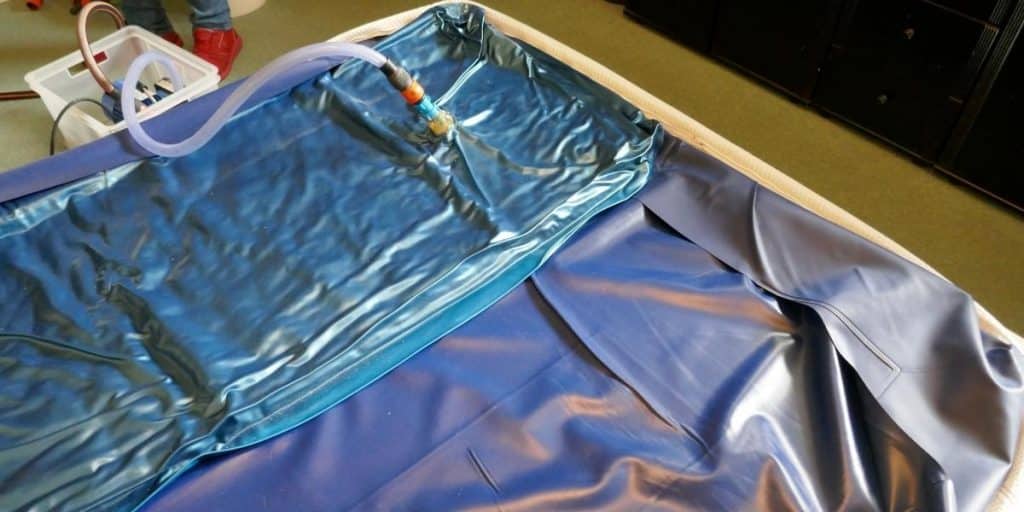
Waterbed mattresses are made of polyvinyl material with a flexible layer. They have water chambers filled with water, depending on your comfort level.
The chambers are rectangular and can be made of wood or foam. The foam chambers make the beds soft, reducing the level of firmness suitable for a kids’ mattress. On the other hand, the wood chambers make the mattress too hard, which can be uncomfortable.
Generally, these mattresses are unsuitable since it’s unlikely to find medium firmness. Additionally, the water makes them too bouncy, making it hard for a child to find balance. Although you can adjust the water levels for required support, the mattress is uncomfortable for a child.
The buoyant sensation can be intimidating, making it difficult for a child to adapt to sleeping independently. There is also the risk of leakage, which can be dangerous to your child.
Some homeowners prohibit tenants from using water mattresses due to the damages associated with them.
4. Standard spring mattresses

The stand sprung mattress is also known as open coil because it consists of an open coil spring system. The springs are made of tensile steel wound into numerous springs connected by a wire or a rod edge. This means the springs function as a single unit.
This makes them unsuitable for a child since they are too bouncy. They also lack the necessary support because they have a low level of firmness, making them unsuitable for back and stomach sleepers. For kids who move a lot, the constant bouncing can make the child lose sleep every time they change position.
Additionally, the standard spring lacks the required firmness to support your child’s back. With prolonged usage, the open coil mattress can dip in the middle, making your child uncomfortable.
Moreover, the springs can be squeaky, creating a disturbance when a child moves. This can compromise the quality of sleep, especially with co-sleepers.
5. Air mattresses

Air mattresses are popular for campers because they’re portable. They have air chambers, and the upholstery material can be foam, latex, or fiber such as cotton or wool.
You can use a pump to fill the chambers with air to your preferred firmness level. This means you can adjust them to fit the firmness required for the kids’ sleeping position.
This mattress is good for support and comfort, ensuring your child enjoys sleep. However, it can be dangerous for toddlers younger than two years since it’s a known cause of sudden infant deaths.
6. Memory foam mattresses
Memory foam is one of the most popular types of mattress for adults and kids.
Unlike regular foam, memory foam has some holes to enhance airflow. This means it releases air fast, ensuring it doesn’t trap a lot of heat nor get too cold. Therefore it’s a comfortable option for kids, especially in cold weather.
Additionally, memory foam can be purchased with a medium level of firmness, and it’s soft. This ensures that it offers support and comfort for your child’s well-being. It has some level of sinkage, giving a snug effect to your little one. The sinkage is also good for pressure relief, especially for older kids.
Recommended Memory Foam Mattress For Kids
Helix Sunset
The helix sunset is one of the best memory foam mattresses for kids. It comprises a layer of springs, three layers of poly foam, and two layers of memory foam.
The memory foam makes the mattresses soft, making your child feel like they’re sinking in a cloud. The layers cushion the pressure points, including the shoulders and hips. This ensures they sleep comfortably and get the necessary support for spine alignment.
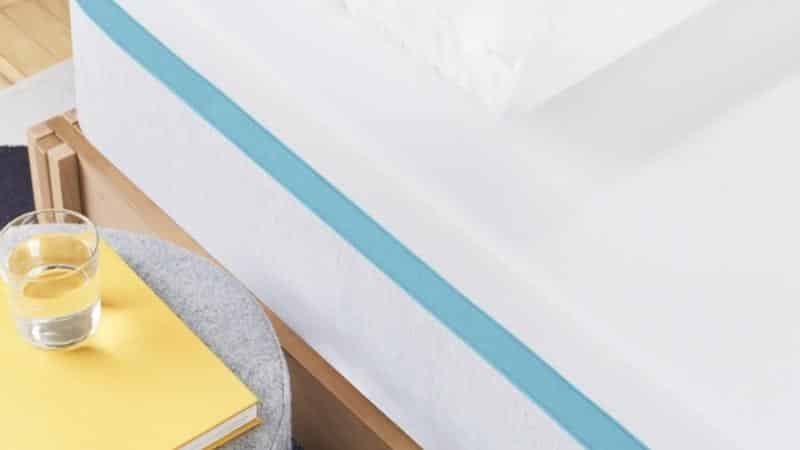
7. Hybrid mattresses

Hybrid mattresses are a combination of memory foam and innerspring. This gives them a firmness level ideal for kids.
The springs are usually pocketed individually to ensure they respond to pressure independently. As a result, they provide unparalleled support for the whole body regardless of the child’s sleeping position.
The layers of memory foam give the mattress a soft feel that relieve pressure. Latex and spring hybrids are also suitable for kids, but they’re uncommon.
Recommended Hybrid Mattress For Kids
Saatva Youth
Saatva is a hybrid mattress for children aged between three and twelve years. It’s the best option when transitioning from crib since your child will grow with it into teenagehood.
It’s double-sided with a softer and firmer side allowing you to flip sides depending on your child’s age and weight.
Both sides are firm enough, allowing the spine’s natural curvature, but the softer side has additional plush foam suitable for younger children and side sleepers.
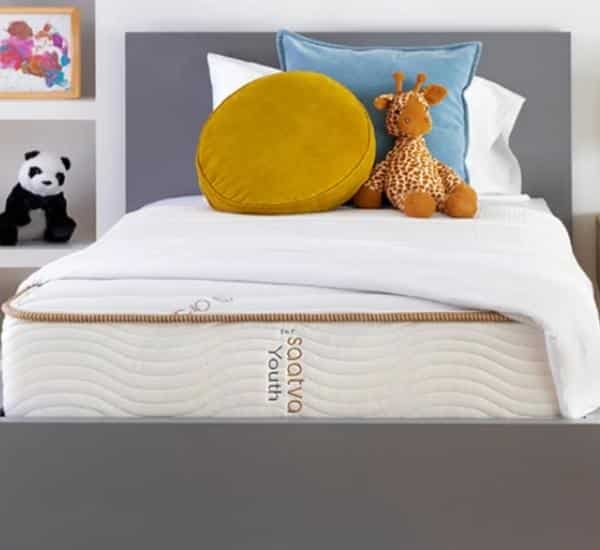
The firmer side has denser foam to support bigger kids, especially stomach and back sleepers. The spring layer ensures the mattress doesn’t sag, and it can maintain its feel for up to ten years. You can use the mattress until your child transitions to the next stage.
8. Gel mattresses
When it comes to kids’ mattresses, you can never go wrong with a gel mattress. The mattresses comprise gel layers combined with latex, memory foam, or both. This ensures that the mattress is soft and has great pressure-relieving properties associated with the gel.
Also, gel infusion is crucial in temperature regulation. Memory foam traps heat which makes your child uncomfortable and sweaty. The gel provides a cooling effect ensuring your child enjoys their sleep.
Since these mattresses fall under the medium-firm bracket, they provide the required level of support while maintaining comfort. The level of sinkage is minimal to allow infusion of the pressure points, making it ideal for all sleeping positions.
Recommended Gel Mattress For Kids
Ghostbed Original’s
This classic latex foam and gel memory combination make it ideal for temperature regulation to keep your child cool. The aerated foam latex layer ensures heat flow from the mattress, reducing sleep disruptions.
Also, the foams maintain a bouncy feel for comfort and pressure relief. The firmness level is ideal for natural spine curvature and is suitable for side, back, and stomach sleepers.
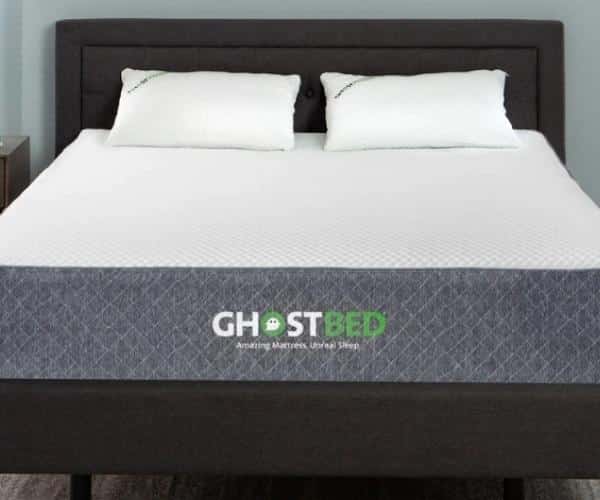
9. Latex mattresses

This is your best mattress option if your child is prone to allergies. In addition, it offers pressure relief and body contouring and maintains the support required for proper spine development.
The bounce feel maximizes comfort, improving the quality of sleep. Unlike the memory foam hybrids, it doesn’t trap heat, nor is it cold like the polyvinyl water mattresses. This means reduced sleep disruptions and sweaty nights.
Depending on your child’s age and weight, you can choose between Dunlop and Talalay latex. With Dunlop mattresses, the latex is molded with a single pour making it firm at the bottom and softer at the top. With Talalay, manufacturers suck the air after molding the latex. Then, it’s frozen to stabilize its structure, making it a bit firmer.
Recommended Latex Mattress For Kids
Awara
Awara is the best kids’ latex mattress comprising organic latex.
The lower layer contains coils to enhance support and improve the bouncy feel. This makes it ideal for all sleeping positions.
The materials complement each other to react to the kid’s movement. Additionally, latex is a great repellant for dander, mites, and mold.
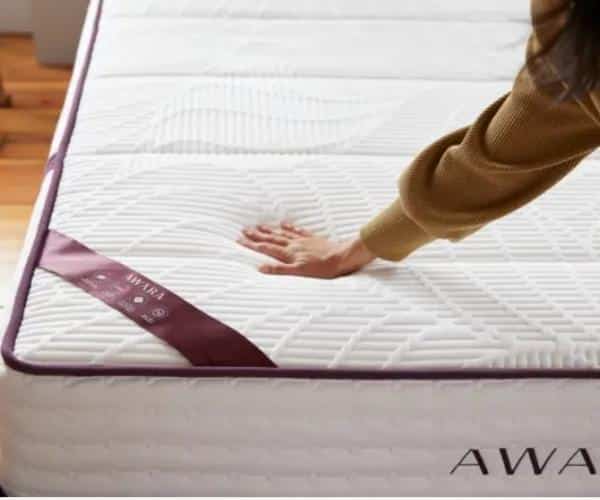
10. Pocket spring mattresses

Investing in a pocket spring mattress is the best way to improve your child’s sleep quality.
Unlike other types, these springs are pocketed individually to ensure they react differently to pressure. As a result, they are the safest for kids of all ages providing maximum support and comfort.
When coupled with memory foam, it provides a great level of sinkage, ensuring your child literally sleeps like a baby. It’s suitable for side, back, and stomach sleepers and those who turn and toss all over the bed.
Recommended Pocket Spring Mattress For Kids
Signature Design
Signature Design By Ashley Chime 8” Firm Innerspring Mattress is one of the top-rated mattresses for your child.
It has quilted foam for enhanced comfort and a strong coil system to support kids of all ages.
Conclusion
The best thing you can do to improve your child’s sleep quality is buy the right mattresses, a mattress suitable for kids.
However, with so many in the market, it can be tricky to find the best. Some of the best kids’ mattresses include pocket spring, latex, and gel mattresses. Make sure to keep off Pillowtop, futon, and waterbed mattresses.
Whichever type you choose, ensure the mattress is medium-firm. This provides the required support for proper spine alignment. A soft mattress makes the child assume a curved sleeping position causing back problems. On the other hand, a hard one can be uncomfortable and rigid, disallowing the spine’s natural curvature.

